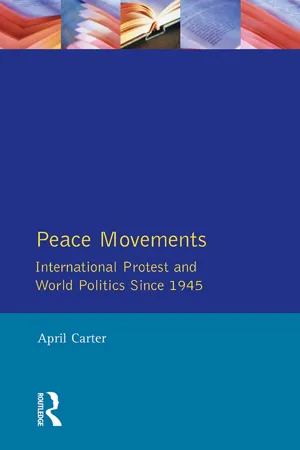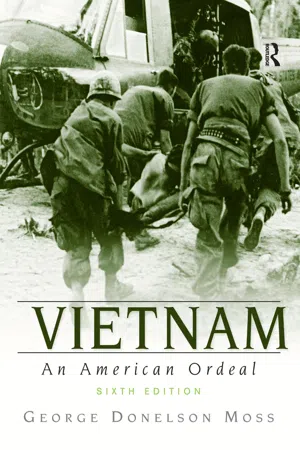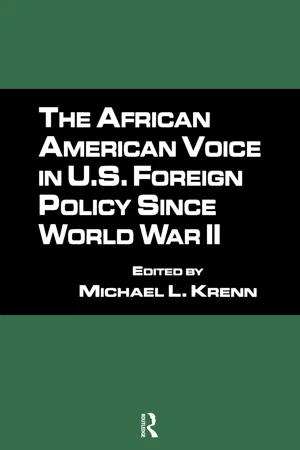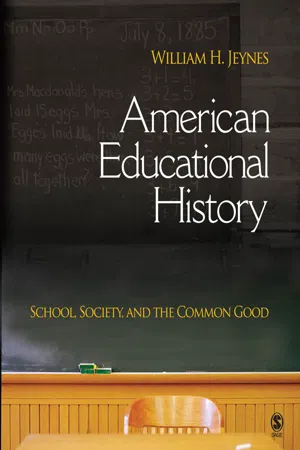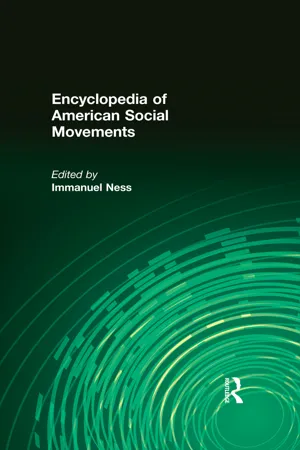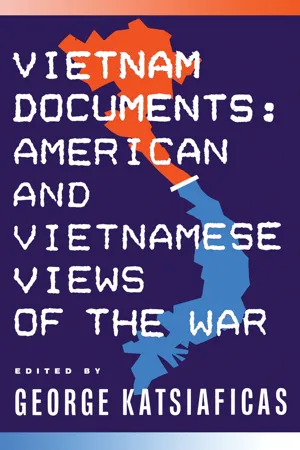History
Vietnam War Protests
The Vietnam War protests were a series of anti-war movements and demonstrations that took place in the United States during the 1960s and 1970s. They were fueled by opposition to the U.S. involvement in the Vietnam War and drew participation from a diverse range of groups, including students, civil rights activists, and religious organizations. These protests played a significant role in shaping public opinion and ultimately influencing government policy regarding the war.
Written by Perlego with AI-assistance
Related key terms
7 Key excerpts on "Vietnam War Protests"
- April Carter(Author)
- 2014(Publication Date)
- Routledge(Publisher)
The Vietnam movement acquired more radical ideas, a bitter tone and a sense of desperation, largely because of the increasing horror and destructiveness of the war itself and its potent images on the television screen. The Vietnam War became for the protesters a symbol of American imperialism employing its technological might to destroy an Asian peasant society. Conversely, the endurance, ingenuity and effectiveness of the Vietnamese guerrillas evoked admiration and encouraged a largely rhetorical call to bring guerrilla tactics into the struggle to stop the war and to overthrow capitalism inside America.The movement against the Vietnam War was also strongly influenced by the wider protest culture of which it became a part. The period 1964–70 saw a series of student campaigns against the administration and ethos of their universities and against the politics and culture of Western societies. The student movement began with the Free Speech Movement in Berkeley, and led towards the end of the 1960s to student strikes and occupation of their universities throughout the United States and Western Europe. The most politically significant student rebellion erupted in May 1968 in France, where de Gaulle’s regime was seriously shaken. The student protesters concerned themselves only intermittently with Vietnam, but the movements inevitably overlapped, especially of course in the USA where the draft confronted all male students. University involvement with defence establishments through research contracts and graduate recruitment was also an issue for student radicals in the USA and Britain. The growth of hippy culture in the 1960s was another important influence on protesters, associating protest with ‘dropping out’ of middle-class society into alternative life-styles projected in music, dress and drugs. Hippy influence imported a gentler and more imaginative strand into protest demonstrations, promoting the imagery of flower-power rather than the power flowing from the barrel of a gun, and was reflected in some of the demonstrations, such as the ‘levitation’ of the Pentagon staged in 1967. But smoking pot and growing long hair alienated working-class and middle-class Americans from the protesters almost as much as throwing stones or brandishing the ‘Vietcong’ flag. The third movement which specifically influenced the American Vietnam protests was the evolution of the Civil Rights campaign into Black Power, with its rejection of the white liberal establishment and the Democratic Party.- eBook - ePub
Vietnam
An American Ordeal
- George Donelson Moss(Author)
- 2016(Publication Date)
- Routledge(Publisher)
Mainstream press coverage of the war was becoming more independent of government influence and more critical of U.S. policy. Antiwar rallies, marches, and demonstrations increased in size, occurred more frequently, and developed more militant tactics during 1967, the first year of significant nationwide protest against the Vietnam War. On April 15, the Spring Mobilization Committee, a coalition of liberal and radical protest leaders, staged large antiwar demonstrations in San Francisco and New York City. About 50,000 people participated in the San Francisco demonstration and as many as 200,000 people converged on New York’s Central Park for an afternoon of speeches and music. 41 Protesters gathered daily in front of the White House to chant, “Hey, hey, LBJ, how many kids have you killed today?” and “Ho, Ho, Ho Chi Minh, [the] NLF is going to win.” 42 The most prominent civil rights leader, Dr. Martin Luther King Jr., joined the antiwar ranks during the spring of 1967, adding greatly to the peace movement’s sense of growth and momentum. In a sermon delivered at New York’s Riverside Church on April 4, 1967, the Nobel laureate established himself as a leading spokesman for the peace cause. He blamed America for the war and called for a speedy end to the fighting. He urged all men of humane conviction to protest the war in whatever way was appropriate. He declared that Vietnam was “a symptom of a far deeper malady” that caused the United States, in the name of anti-Communism, to oppose the rightful demands of oppressed people everywhere who were seeking freedom and dignity. King claimed that anti-Communism had caused America to stray from its commitments to brotherhood and peace, and he called upon his country to return to its rightful home. 43 Another prominent African American also defied the government’s war policy. Heavyweight boxing champion Muhammad Ali, a devout member of the Nation of Islam sect, refused induction into the Army on religious grounds - Michael L. Krenn(Author)
- 2019(Publication Date)
- Routledge(Publisher)
By ADAM FAIRCLOUGHMartin Luther King, Jr. and theWar in Vietnam
T HE 1960s WITNESSED two of the most profound social movements of twentieth-century America: the civil rights movement and the protests against American participation in the war in Vietnam. Both directly involved hundreds of thousands of people; both attracted widespread media attention. Both operated, for the most part, outside conventional political channels, relying instead on marches, demonstrations, rallies, and other forms of nonviolent protest. And they were both movements of, primarily, young people.Here, however, the similarities end. The civil rights movement was led by blacks and supported by a coalition of blacks and whites. The peace movement, although interracial, was overwhelmingly white. The civil rights movement possessed a unity, organizational coherence, and stability of leadership that contrasted sharply with the diffuse, variegated, and anarchic anti-war forces. Equally important, the former adhered to the strict discipline of nonviolence; the latter contained elements that engaged in provocation, confrontation, the destruction of property, and even terrorism. These differences may explain, in part, why the two movements had such widely different results. The one generated widespread public sympathy and helped to persuade both President and Congress to support its goals. The Civil Rights Act of 1964 and the Voting Rights Act of 1965 are enduring monuments to its success. The impact of the anti-war movement, on the other hand, is far more problematic. Although it certainly contributed to the political downfall of Lyndon Johnson, it is far from clear that it hastened American disengagement from Vietnam. Indeed, insofar as it indirectly assisted the election of Richard Nixon, who, as Michael Dorman noted, “showed no tendency … to be moved by anti-war confrontations,” it may even have delayed American withdrawal.1- eBook - ePub
Vietnam
Explaining America's Lost War
- Gary R. Hess(Author)
- 2015(Publication Date)
- Wiley-Blackwell(Publisher)
I. F. Stone’s Weekly became a widely-read among antiwar advocates, argued that the State Department rationale was based on a misunderstanding of Vietnamese history and ignored the legitimate grievances of the South Vietnamese people against their authoritarian and repressive government, which the US had been supporting for a decade. The US, Stone, and other critics argued, was intervening in a Vietnamese civil war.Debating the War, 1965–1968: The Power–Morality Issue
From these beginnings in early 1965 and accelerating as involvement in Vietnam steadily escalated over the next three years, a debate between “doves” and “hawks” enveloped the American public. Notably, both sides claimed the moral high ground. Through demonstrations, marches, speeches, and other forms of nonviolent protest – including defiance of the selective service system that drafted young men into military service – opponents of the war carried their message that America was fighting an immoral war. To doves, the US needed to disengage, through withdrawal or negotiated settlement, from an untenable position. The protesters were challenged by pro-war groups who engaged in counter-demonstrations and marches to make their point that the war was necessary to defend freedom and to halt the spread of communism. To them, the war had the high moral purpose of upholding the freedom of the South Vietnamese.The debate seemed chaotic. The antiwar side attracted a diverse range of individuals and organizations. While many men and women were drawn to political action for the first time, others had been involved in pacifist, anti-nuclear, feminist, and civil rights movements. Protest often lacked coordination and planning. The principal scholars of the antiwar movement write: “there were many antiwar movements in America. Protest had many masks, so different that some observers contended that there was no such thing as an antiwar movement.” That confusing diversity however, also reflected strength: “the spasmodic, haphazard, frustrated, fatigued, and incoherent [protest] reflect[ed] the character of the peace and antiwar movement rather than a denial of its existence.”2 - eBook - ePub
American Educational History
School, Society, and the Common Good
- William H. Jeynes(Author)
- 2007(Publication Date)
- SAGE Publications, Inc(Publisher)
Just as the other major wars in American history impacted schooling to a great degree, the Vietnam War was no exception (Ravitch, 1983). The student activism of the 1960s cannot be separated from the existence of the Vietnam War. Without the Vietnam War, demonstrations that students initiated would likely have been isolated and would not have possessed the intensity of those during the Vietnam War (Goines, 2001).Some Context Regarding Student Demonstrations
Those who do not remember the 1960s might wonder why the student demonstrations concerning the war became so poignant. There are a number of reasons for this, but a prominent one is that many Americans were simply becoming satiated with war (Johnson, 1997). From 1941 to 1945, Americans were engaged in World War II; during the early 1950s, tens of thousands of GIs lost their lives in the Korean War; then there was the Bay of Pigs invasion, the Cuban Missile Crisis, and interventions in Greece and Central America. Finally, in the 1960s, there was yet another conflict, the Vietnam War. Americans were becoming satiated with war and the fact that many nations somehow expected the United States to be the world’s police force (Miles, 2004).The Vietnam War constituted one of the major events of the Cold War. The French tried and failed to fend off the communist takeover of South Vietnam led by Ho Chi Minh. Once the French realized that victory in the war was not achievable for them, they desired to “hand the baton” to the United States (Smith, 1983). However, having just completed the Korean War, President Eisenhower showed no particular predilection for committing American troops to Vietnam (Johnson 1997; Smith, 1983). He did send a small group of military advisors, but he did not anticipate that any greater commitment would be needed (Morin, 1969; Smith, 1983).Once he assumed the role of president, John F. Kennedy was much more concerned about the situation in Vietnam. The Cuban Missile Crisis convinced Kennedy that to lose key battles in the Cold War could bring the threat of communism in close proximity to America’s shores (Kaiser, 2000; Paterson, 1989). Kennedy had run against Richard Nixon, claiming that Eisenhower had been too soft on communism (Johnson, 1997; Kaiser, 2000; Paterson, 1989). This claim, we now know, has a certain irony to it, given that it was Eisenhower’s threat of using nuclear weapons that helped end the Korean War (Morin, 1969). Neither Kennedy nor the American public was cognizant of this fact at the time (Kaiser, 2000; Paterson, 1989). Consistent with Kennedy’s position in reference to Nixon, he had developed a reputation of being a staunch anticommunist, and he displayed this trait in his dealings with Cuba and Vietnam (Kaiser, 2000; Paterson, 1989). Kennedy sent numerous military advisors to Vietnam and anticipated that sending American troops might be necessary. Nevertheless, Kennedy sent far fewer U.S. troops than did Lyndon Johnson, who would eventually replace Kennedy as president, and there was still very little concern about Vietnam among college students (Kaiser, 2000; Paterson, 1989). - eBook - ePub
- Immanuel Ness(Author)
- 2015(Publication Date)
- Routledge(Publisher)
Wracked by internal dissension and external opposition, about all that kept the antiwar forces of the late 1960s together and moving was Washington's continued prosecution of the war. The imperative for action was constant. Republican Richard Nixon came to the presidency on a platform of "Peace with Honor." But when he unveiled his peace plans in May 1969, activists recognized that his peace required continued military support for South Vietnam and quickly mobilized in protest. That fall, the movement staged two of its largest and most impressive demonstrations. The first, the Moratorium, drew from the grassroots organizing experience of antiwar liberals and Democrats involved in the 1968 presidential campaign. On October 15, over a quarter of a million Americans—students, workers, housewives, and politicians—removed themselves from their day-to-day responsibilities and gathered in their cities and hometowns to express their desire to end the war. A month later, a coalition on the left organized the fall Mobilization, attracting more than 800,000 people in two large protests in San Francisco and Washington, D.C. The Mobilization's high point came during the thirty-eight-hour "March Against Death," where a seemingly endless line of participants, each carrying a placard with the name of an American killed in Vietnam, marched from Arlington Cemetery to the White House and placed the placards, one by one, into a series of wooden coffins. The success of these protests belied the disarray that was ravaging the movement. Nevertheless, when Nixon announced the U.S. invasion of Cambodia in late April 1970, the movement rallied in a spontaneous wave of protest.These demonstrations were, more than anything, displays of reaction rather than proactive programs of organized political dissent, but there was no doubt that they were spreading. The May protests, for example, arose specifically in response to the Cambodia invasion. When they ended in tragedy on May 4 at Kent State University and two days later at Jackson State, after the National Guard and local police shot into crowds of unarmed students, college campuses rose up in revolt. Spontaneous student strikes shut down almost 500 colleges and universities. Veterans similarly began to organize, coming together as Vietnam Veterans Against the War in public demonstrations that stunned the nation and infuriated the president. With each escalation of the war, the protest movement escalated as well. But it was a movement held together by little more than a shared disgust with the war.McGovern’s Campaign to End the War
Protests persisted through the early 1970s, and although militant demonstrations still stood at the center of media coverage of the movement, liberals had actually started to make significant gains. Efforts at education, lobbying, and outreach had begun to influence the contours of congressional political debate. In 1972, Democratic presidential candidate George McGovern openly stated his plans to withdraw U.S. forces from Vietnam. By the time an agreement was reached on the Paris Peace Accords in January 1973, organizers representing the liberal wing of the movement had forged the strongest antiwar coalition ever, gaining support from McGovern's campaign, the labor movement, and traditional pacifist stalwarts like SANE, WILPF, and the AFSC. - eBook - ePub
Vietnam Documents: American and Vietnamese Views
American and Vietnamese Views
- George Katsiaficas(Author)
- 2016(Publication Date)
- Routledge(Publisher)
Chapter VI The Antiwar MovementDOI: 10.4324/9781315698366-6The American people have always been hesitant to become involved in foreign wars. During nearly every major war this country has waged, there has been a protest movement against it. Notable were the small but articulate movements against the Mexican War of 1846-1848 and the conquest of the Philippines from 1899-1901. Because of the public's unwillingness to go to war, even the country's entrances into World War I and World War II were delayed for years.With this historical background, it should not be surprising that a powerful antiwar movement existed in the United States during the Vietnam War, a movement that increasingly affected even the most conservative (pro-military) segments of the population. One of the reasons for the vast size of the antiwar movement was the simple fact, intuitively obvious to the most casual observer, that Vietnam posed no direct danger to American lives or property. Unlike other wars in the twentieth century where the enemy attacked or threatened the United States, no case could be made at any point that Vietnamese presented any direct danger to Americans. There was never even a hint that North Vietnam or the NLF might have nuclear weapons, chemical weapons, or any of the kinds of weapons that, more recently, it was thought that Saddam Hussein possessed in 1991.Although not well known, the impact of the antiwar movement on policymakers was critical in preventing the war's escalation. In November 1969, as we know today from Richard Nixon's memoirs, the president was prevented from using nuclear weapons against North Vietnam by the hundreds of thousands of people who marched in the United States. Years earlier, the power of protesters was felt by Lyndon Johnson. In August 1966, his military chiefs had urged massive bombing of Hanoi and Haiphong to speed the end of the war. To make their case, the generals arranged for Johnson to meet the Pentagon's computer experts, men who had calculated that three quarters of a million lives had been saved by using atomic bombs against Japan and that a similar number could be saved again through attacks on the North's urban areas. LBJ heard them out before interrupting, "I have one more problem for your computer—how long will it take 500,000 angry Americans to climb that White House wall out there and lynch their president if he does something like that?"
Learn about this page
Index pages curate the most relevant extracts from our library of academic textbooks. They’ve been created using an in-house natural language model (NLM), each adding context and meaning to key research topics.
